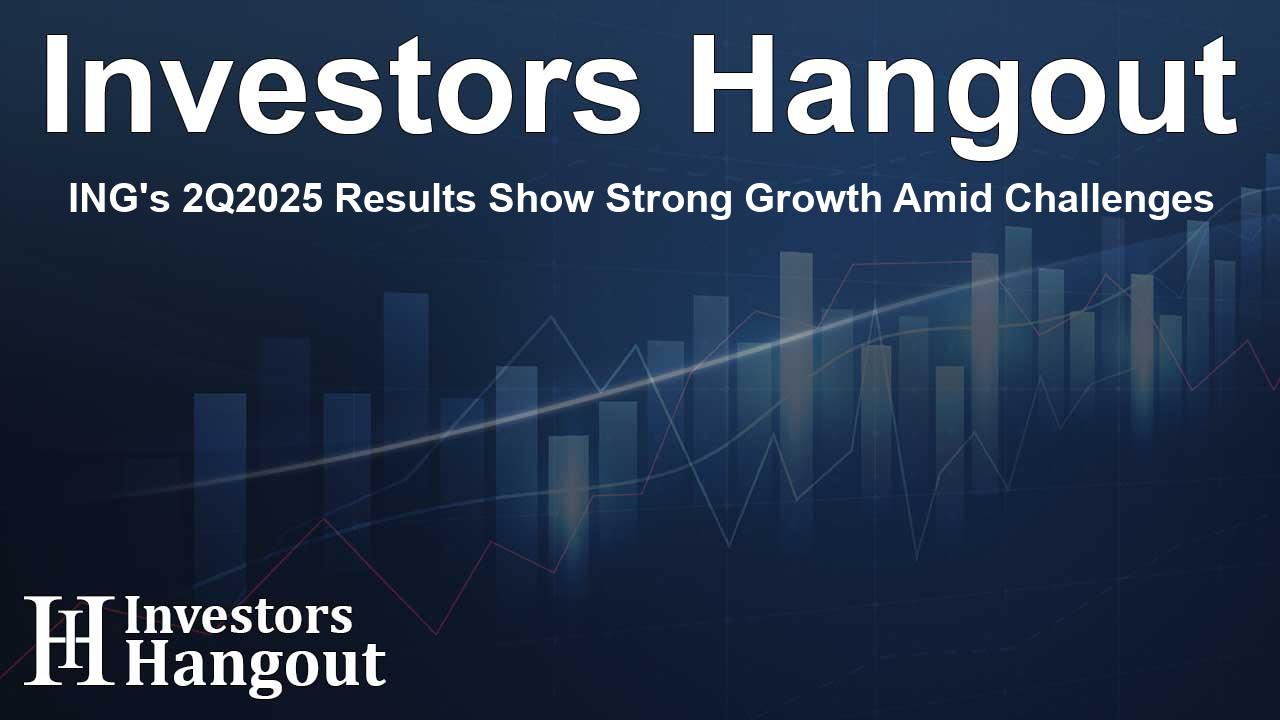ING's 2Q2025 Results Show Strong Growth Amid Challenges

ING Posts Impressive 2Q2025 Results
ING has once again demonstrated its resilience by announcing a remarkable net result of €1,675 million for the second quarter of 2025. This strong performance was fueled by significant growth in both lending volumes and fee income, indicating a positive trajectory for the company's 'Growing the difference' strategy established last year.
Profit Before Tax and Customer Growth
For 2Q2025, ING's profit before tax surged to €2,369 million. The bank also reported a robust Common Equity Tier 1 (CET1) ratio standing at 13.3%. This impressive financial stability plays a crucial role in the institution's commitment to achieving its targets ahead of schedule. Excitingly, the customer base cultivated a strong growth spurt, with an increase of over 300,000 new mobile primary customers, leading to a total of 14.9 million.
Driving Factors Behind Revenue Growth
The resilient performance of ING can be attributed to several key factors. The total income exhibited stability, primarily supported by higher customer balances. The mortgage portfolio performed exceptionally well, reflecting the growing demand for home loans across various markets, particularly in the Netherlands and Australia. Additionally, ING experienced a double-digit growth in fee income across Retail and Wholesale Banking, highlighting an increase of 12% year-on-year.
Commitment to Shareholders
In line with its strong earnings, ING confirmed it will distribute an interim cash dividend of €0.35 per ordinary share. This move underscores the bank's dedication to returning value to its shareholders while simultaneously investing in further growth opportunities.
CEO Insights on Strategic Execution
Steven van Rijswijk, CEO of ING, shared insights about the company's strategy during a particularly volatile economic context characterized by macroeconomic and geopolitical uncertainties. He emphasized the importance of diversifying income streams, noting that fees now represent nearly 20% of the bank's total income. This diversification strategy is evident as the company remains on track to achieve its financial objectives for 2027.
Commercial Momentum and Customer Demand
Despite external pressures, ING has maintained strong commercial momentum. The bank achieved record net core lending growth of €11.3 billion during the quarter, with €7.2 billion attributed to mortgages and €3.2 billion coming from Business Banking. The increased demand from small and medium-sized enterprises (SMEs) has also contributed to this surge in lending. Furthermore, ING welcomed a notable influx of €8.9 billion in net customer deposits, which can be partially attributed to seasonal holiday allowances.
Wholesale Banking Developments
In Wholesale Banking, net core lending growth reached €4.1 billion, driven by sustained demand in Working Capital Solutions and short-term trade financing. While demand for long-term corporate loans has experienced some decline due to economic uncertainty, the overall rise in fees from Lending, Global Capital Markets, and Payments & Cash Management reflects the robust health of this sector.
Cost Management and Efficiency Measures
Throughout the quarter, ING managed costs prudently, achieving moderate year-on-year increases while implementing measures to counteract inflationary pressures. This involved optimizing the Know Your Customer (KYC) processes and restructuring parts of the Wholesale Banking workforce. Despite these challenges, ING invested continuously in enhancing both retail and wholesale banking capabilities to better serve clients.
Focus on Sustainability
ING's commitment to sustainability has not waned, as the bank mobilized a substantial €67.8 billion in sustainable volume for the first half of 2025, marking a 19% year-over-year increase. The introduction of a new mortgage pricing model in the Netherlands that ties interest rates to energy labels exemplifies ING's forward-thinking approach to socially responsible banking.
Conclusion
Despite the macroeconomic challenges, ING's results for the first half of 2025 reflect a powerful execution of its strategic initiatives geared towards growth and sustainability. The leadership remains confident in the bank's direction, bolstered by the trust of its customers and the unwavering dedication of its employees.
Frequently Asked Questions
What were ING's net results for 2Q2025?
ING reported a net result of €1,675 million for the second quarter of 2025.
How much was the profit before tax for ING in 2Q2025?
The profit before tax was €2,369 million.
What growth did ING experience in terms of mobile customers?
ING added over 300,000 new mobile primary customers, totaling 14.9 million.
How did ING's CET1 ratio perform?
The CET1 ratio stood at 13.3%, indicating strong financial stability.
What is ING's approach to sustainability?
ING mobilized €67.8 billion in sustainable volume in the first half of 2025, emphasizing its commitment to environmentally responsible banking.
About The Author
Contact Evelyn Baker privately here. Or send an email with ATTN: Evelyn Baker as the subject to contact@investorshangout.com.
About Investors Hangout
Investors Hangout is a leading online stock forum for financial discussion and learning, offering a wide range of free tools and resources. It draws in traders of all levels, who exchange market knowledge, investigate trading tactics, and keep an eye on industry developments in real time. Featuring financial articles, stock message boards, quotes, charts, company profiles, and live news updates. Through cooperative learning and a wealth of informational resources, it helps users from novices creating their first portfolios to experts honing their techniques. Join Investors Hangout today: https://investorshangout.com/
The content of this article is based on factual, publicly available information and does not represent legal, financial, or investment advice. Investors Hangout does not offer financial advice, and the author is not a licensed financial advisor. Consult a qualified advisor before making any financial or investment decisions based on this article. This article should not be considered advice to purchase, sell, or hold any securities or other investments. If any of the material provided here is inaccurate, please contact us for corrections.
